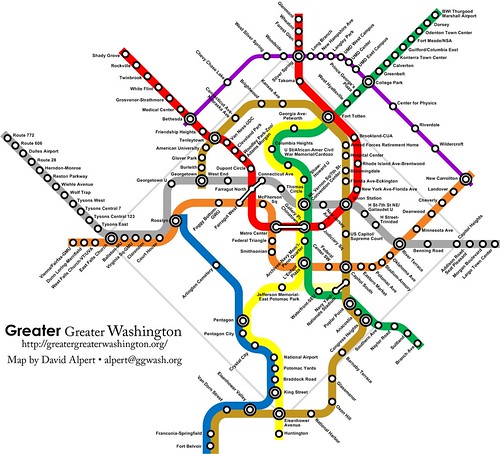Another lesson in failures when you don't do mass transit planning at the metropolitan scale
Today's Post reports in "Operating Silver Line could cost Metro millions more than expected" that the cost of operating the Silver Line subway expansion line will likely increase, because trains won't be able to turn back (like how Red Line trains don't necessarily go all the way to Shady Grove on the western leg, but turn back at Grosvenor) before the far eastern terminus of the blue line at Largo. This means that rather than concentrate service in the areas of highest demand, more trains are required to provide the desired level of service.
I couldn't begin to count the number of times I've written about how the metropolitan area needs to do transportation planning in an integrated fashion, how WMATA's devolution of expansion planning and construction to the separate jurisdictions leads to problems such as this one, because Virginia, in planning the Silver Line, did not take on any responsibility for considering, addressing, AND PAYING FOR/mitigating the potential negative impacts the expansion would have elsewhere in the system.
And in 2006, I suggested that the Silver Line could have been the way to jumpstart and create the separated blue line, and add a second "Rosslyn" crossing, thereby adding crossing capacity in the system's most congested crossing, and also providing the means to spearhead the creation of the separated blue line, which would add capacity in the core of the system--the subway system is projected to reach capacity by the middle of the next decade and so far there are no active plans to address this reality--serve new areas, and provide redundancy as well.
While I can't find the original post (Blogger only indexes the last 5,000 posts and I have over 8,000), this one from 2011 recaps the argument, "Silver Line Metro expansion a classic example of the need to have true regional transportation planning."
In this conceptual map (produced for me a few years ago, graciously, by David Alpert of Greater Greater Washington), I proposed that the Silver Line could in fact amalgamate the blue line eastward from Rosslyn.

The map also shows the Purple Line light rail system and a proposed "Brown Line" concept first put forth by MVJantzen in an e-conversation, although I modified his concept some. Note that the blue line southern terminus has been extended to Fort Belvoir. If that were done, it would make sense to have a couple of stations in between Franconia-Springfield and Fort Belvoir, serving the Rte. 1 corridor in Fairfax County, and providing opportunities for intensification and redevelopment (something I am meaning to write about in conjunction with the opening of the new apartment building, the Beacon of Groveton, by Wood Partners, adjacent to that Lowes-Target shopping center).
Even if the Silver Line creation wasn't used to create the separated blue line, at the very least, as part of the agreement for constructing and operating the line, Virginia should have been required to pay for--at least in large part--a second crossing of the Potomac River and definitely the full cost of creating a turnback switch at Stadium-Armory Station. (This is not unlike how I suggest in this post, "From the files: transit planning in Baltimore County," that Baltimore County has a lot of interest in the creation of a direct connection between the light rail and the subway at the old Hutzler's Department Store in Baltimore, because it would make fixed rail transit service more efficient for more Baltimore County residents, even though the physical location of the improvement would be in Baltimore City.)
The evident gaps in transportation planning in DC and the Washington Metropolitan Area generally, along with the almost annual transit service cuts made in response to budget pressures led me to create a presentation on mass transit planning ought to be done in a metropolitan area--at the scale of the metropolitan area and independent of the transit operator(s).
That presentation is linked to here: Metropolitan Mass Transit Planning presentation and I made the first and only presentation at the U of Delaware urban studies program in the Spring of 2010. (The only thing that really needs to be added is a couple slides on dedicated transit networks at the core, and probably some discussion on financing along the lines of the discussion in "Commuter/mobility tax discussion for DC.")
-----
Again, it's so !@#$%^&*() frustrating that these predictable problems could be avoided were planning and planners "better".
Labels: public finance and spending, transit infrastructure, transportation planning



2 Comments:
It's amazing that a new Potomac crossing and crosstown subway are not even on the radar screen for DC leaders. It's nothing short of a dereliction of duty.
Well, whenever I get around to doing a detailed analysis of the DC "ec. dev. plan" this kind of issue will be front and center in my response.
... AND I was at a presentation in Arlington on Thursday (haven't written about it yet) where a developer on the panel mentioned off-handedly the ArCo Chamber of Commerce's "green business" committee. I said to another developer that I was willing to bet him $100 that DC's chamber doesn't have an equivalent committee.
And yes, I am right:
http://www.dcchamber.org/participate/committees.aspx
interesting that the DC chamber's committees are all internally focused, other than govt. affairs, but that likely has an insular focus as well.
Post a Comment
<< Home